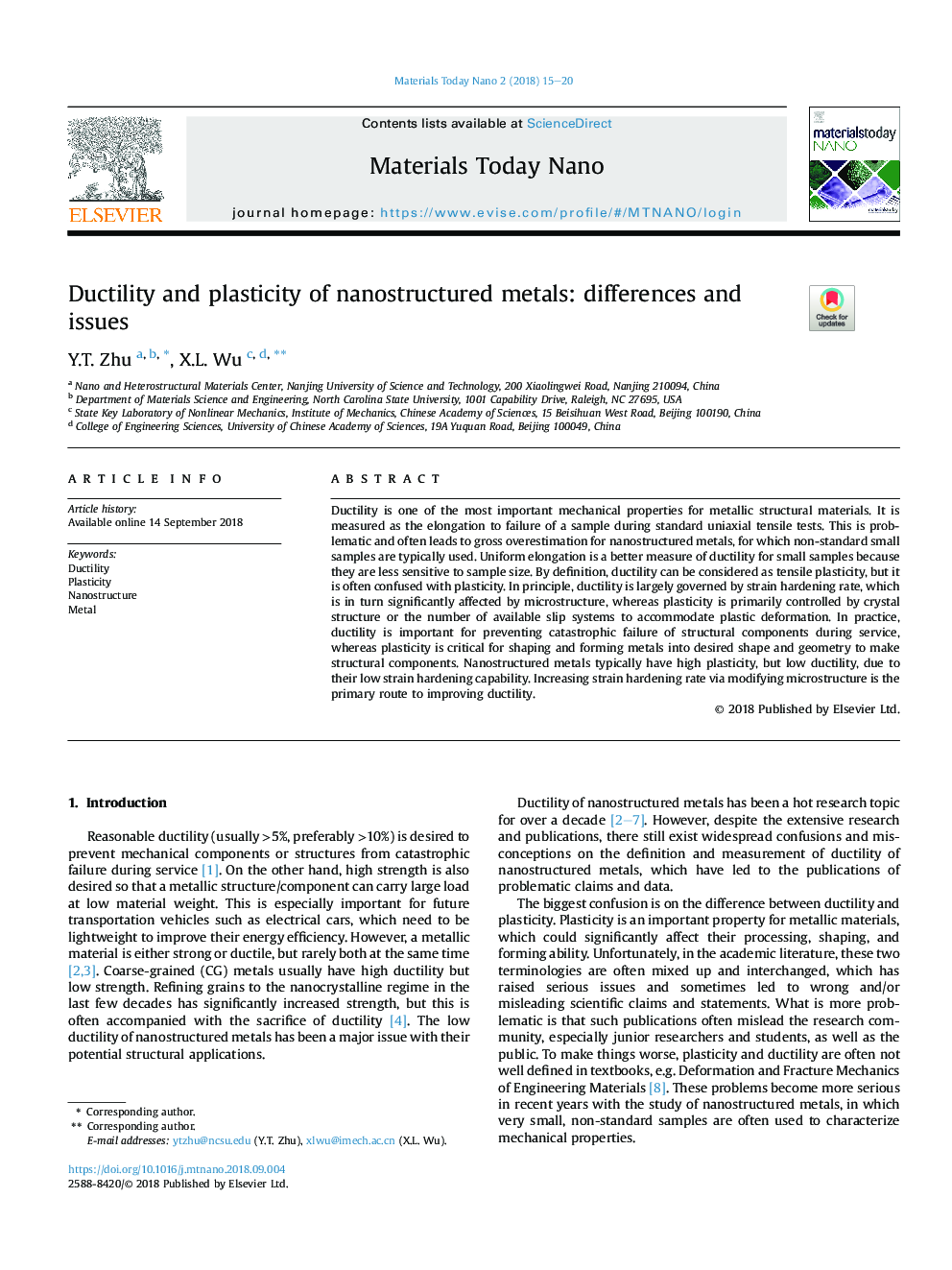| کد مقاله | کد نشریه | سال انتشار | مقاله انگلیسی | نسخه تمام متن |
|---|---|---|---|---|
| 10999761 | 1415905 | 2018 | 6 صفحه PDF | دانلود رایگان |
عنوان انگلیسی مقاله ISI
Ductility and plasticity of nanostructured metals: differences and issues
ترجمه فارسی عنوان
انعطاف پذیری و پلاستیکی فلزات نانوساختار: تفاوت ها و مسائل
دانلود مقاله + سفارش ترجمه
دانلود مقاله ISI انگلیسی
رایگان برای ایرانیان
کلمات کلیدی
شکل پذیری، پلاستیک نانوساختار، فلز،
ترجمه چکیده
چسبندگی یکی از مهمترین خواص مکانیکی برای مواد ساختمانی فلزی است. این اندازه گیری به عنوان طول کشیدن به شکست یک نمونه در طول آزمون کششی استاندارد یک طرفه است. این مسئله مشکل است و اغلب منجر به غلظت بیش از حد فلزات نانوساختار می شود که برای نمونه های غیر استاندارد نمونه های کوچک به طور معمول استفاده می شود. انحنای یکنواخت یک اندازه گیری بهتر از انعطاف پذیری برای نمونه های کوچک است، زیرا آنها کمتر به اندازه نمونه حساس هستند. با تعریف، انعطاف پذیری را می توان به عنوان کشش کششی درنظر گرفت، اما اغلب با پلاستیسیته اشتباه گرفته می شود. در اصل، انعطاف پذیری عمدتا توسط میزان سخت شدن فشار است که به نوبه خود به طور قابل ملاحظه ای توسط میکروساختار تحت تاثیر قرار می گیرد، در حالی که پلاستیک در ابتدا توسط ساختار بلوری یا تعداد سیستم های لغزش موجود برای جایگزینی تغییر شکل پلاستیک کنترل می شود. در عمل، انعطاف پذیری برای جلوگیری از شکست فاجعه بار اجزای سازه در خدمت مهم است، در حالی که پلاستیک برای شکل دادن و شکل دادن فلزات به شکل مورد نظر و هندسه برای ساخت اجزای سازنده حیاتی است. فلزات نانوساختار به طور خاص دارای قابلیت پلاستیسیته بالا، اما قابلیت انعطاف پذیری کم را دارند. افزایش میزان سخت شدن فشار از طریق اصلاح ریزساختار، مسیر اولیه برای بهبود قابلیت انعطاف پذیری است.
موضوعات مرتبط
مهندسی و علوم پایه
شیمی
شیمی (عمومی)
چکیده انگلیسی
Ductility is one of the most important mechanical properties for metallic structural materials. It is measured as the elongation to failure of a sample during standard uniaxial tensile tests. This is problematic and often leads to gross overestimation for nanostructured metals, for which non-standard small samples are typically used. Uniform elongation is a better measure of ductility for small samples because they are less sensitive to sample size. By definition, ductility can be considered as tensile plasticity, but it is often confused with plasticity. In principle, ductility is largely governed by strain hardening rate, which is in turn significantly affected by microstructure, whereas plasticity is primarily controlled by crystal structure or the number of available slip systems to accommodate plastic deformation. In practice, ductility is important for preventing catastrophic failure of structural components during service, whereas plasticity is critical for shaping and forming metals into desired shape and geometry to make structural components. Nanostructured metals typically have high plasticity, but low ductility, due to their low strain hardening capability. Increasing strain hardening rate via modifying microstructure is the primary route to improving ductility.
ناشر
Database: Elsevier - ScienceDirect (ساینس دایرکت)
Journal: Materials Today Nano - Volume 2, June 2018, Pages 15-20
Journal: Materials Today Nano - Volume 2, June 2018, Pages 15-20
نویسندگان
Y.T. Zhu, X.L. Wu,
